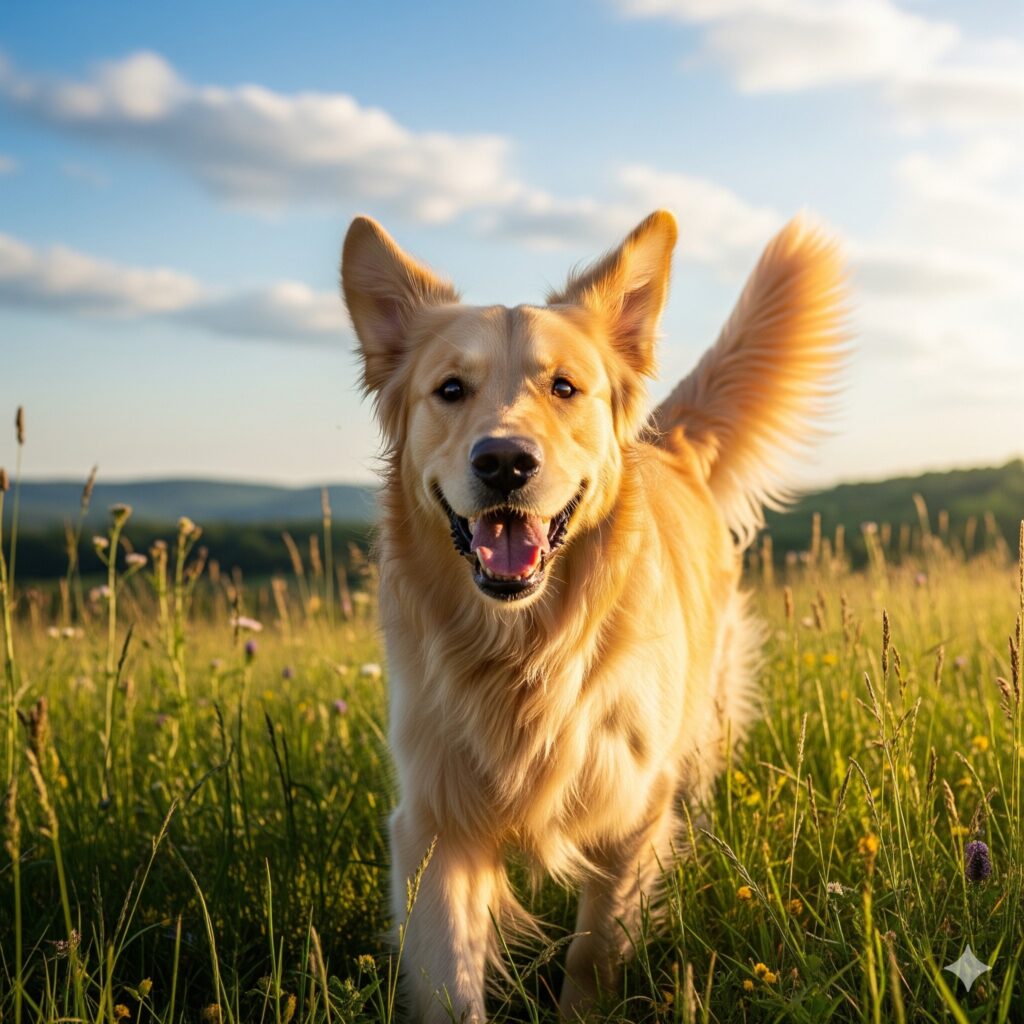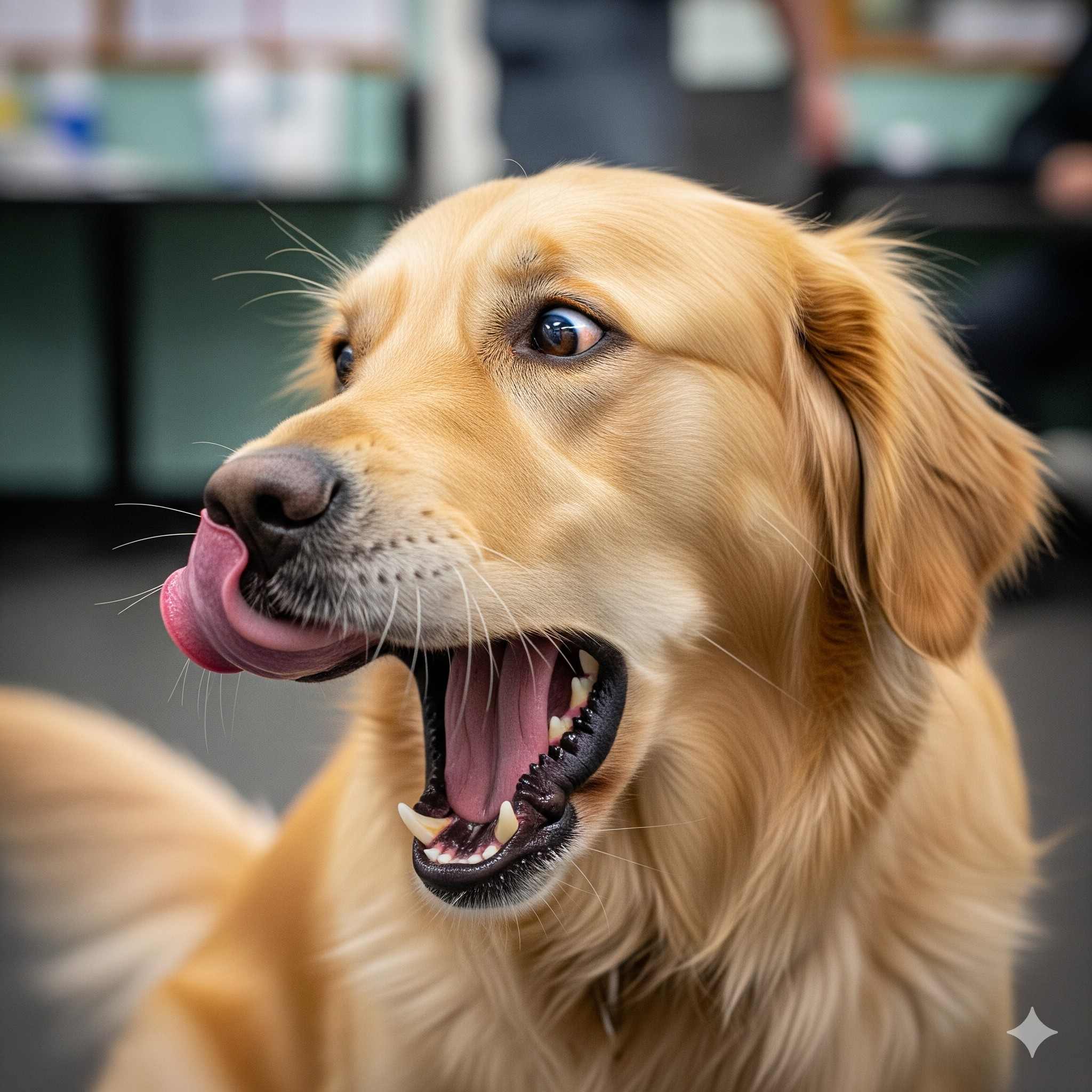Dog Body Language Guide: This wouldn’t be a calculator, but it would be an essential resource. It would be a guide with clear illustrations or descriptions of common dog body language cues. It could cover topics like a wagging tail’s true meaning, what it means when a dog yawns or licks its lips, and signs of stress or fear.
Understanding Your Dog’s Language
A guide to decoding your dog’s body language, from tail wags to subtle cues. Learning to “read” your dog can help you build a stronger bond and ensure their happiness and safety.
Important Note
This guide is for informational purposes only. If you have concerns about your dog’s behavior, always consult a professional dog trainer or a veterinary behaviorist.
➡️ The Misunderstood Tail Wag
A wagging tail doesn’t always mean happiness. The speed, direction, and height of the wag are key to understanding a dog’s mood.
What to Look For:
- **Loose, Wide Wag:** A relaxed, full-body wag is a sign of a happy, friendly dog.
- **Stiff, High Wag:** Often a sign of arousal or anxiety, not happiness. It’s a “stay away” signal.
- **Low, Slow Wag:** Can be a sign of nervousness or uncertainty.
- **Wagging to the Right:** Some studies suggest a wag to the right (from the dog’s perspective) indicates positive feelings, while a wag to the left indicates negative emotions.
😬 Signs of Stress & Anxiety
Dogs use a variety of “calming signals” to communicate that they are uncomfortable. Recognizing these can prevent a situation from escalating.
Key Stress Cues:
- **Yawning & Lip Licking:** These are often not signs of tiredness or hunger, but a way for a dog to say, “I’m stressed.”
- **Tucked Tail & Flattened Ears:** A clear sign of fear and submission.
- **Averted Gaze:** If a dog avoids eye contact, it may feel threatened.
- **Showing the “Whites” of Their Eyes:** Known as “whale eye,” this is a strong sign of fear or aggression.
- **Shaking or Trembling:** While it can be due to cold, it is a very common sign of fear.
⚠️ Warning Signs of Aggression
These are clear signals that a dog is uncomfortable and may bite if the situation does not change.
- **Stiff, Frozen Stance:** The dog’s body becomes rigid.
- **Raised Hackles:** The hair on the back of the neck and spine stands up.
- **Growling & Snarling:** Audible warnings that you should stop what you are doing.
- **A Quick Snap or Bite:** The final warning when all other signals have been ignored.
😊 Signs of Relaxation & Joy
Knowing a happy dog’s body language is just as important as knowing a stressed one’s.
- **Relaxed Posture:** A loose body, soft gaze, and wagging tail.
- **”Play Bow”:** The front end is down with the hind end in the air, a classic invitation to play.
- **Exposed Belly:** A dog rolling onto its back with a relaxed posture shows ultimate trust and comfort.
- **Relaxed Mouth:** A slightly open mouth with a “soft” expression.
Understanding your dog’s language is a key step to a happy, healthy relationship.
Dog Body Language: What Your Dog is Trying to Tell You!
Have you ever wished you could understand what your dog is thinking? You might not speak “dog,” but your dog is talking to you all the time! They use their bodies to tell you if they’re happy, scared, playful, or even if they want you to leave them alone. Learning to “read” your dog’s body language is like learning a secret language. It helps you become a super-communicator with your best friend, making your bond stronger and keeping everyone safe.
This guide will help you decode your dog’s secret signals, from their tail wags to their ears, eyes, and even how they stand. Let’s become dog-language experts!
Important Note: This guide is for learning and fun! If you’re ever worried about your dog’s behavior or if they seem really stressed or aggressive, always talk to a professional dog trainer or a special kind of vet called a veterinary behaviorist. They are the experts who can help you understand and solve tough behavior problems.
Table of Contents
1. The Misunderstood Tail Wag: More Than Just Happy!
When a dog wags its tail, most people think, “Oh, it’s happy!” While a wagging tail can mean happiness, it’s not always the case. The tail wag is actually one of the most misunderstood parts of dog language. To truly understand it, you need to look at how it’s wagging: the speed, how high it is, and even which way it leans.
- Loose, Wide Wag (Wagging their whole body!): This is the classic “happy dog” wag. When a dog’s tail is wagging big and wide, and their whole body wiggles along with it, it means they are relaxed, excited in a good way, and friendly. This is an invitation to come say hello!
- Stiff, High Wag (Like a flagpole): This kind of wag is NOT usually a sign of happiness. If a dog’s tail is held high and is wagging quickly but in a stiff, small way, it often means the dog is feeling anxious, excited, or even a little bit threatened. It’s like them saying, “I’m on alert, stay away.”
- Low, Slow Wag (Between their legs): A tail held low, sometimes even tucked between their legs, and wagging slowly often means the dog is nervous, uncertain, or feeling submissive (like they’re trying to show they’re not a threat).
- Wagging to the Right vs. Left: This is a super interesting scientific discovery! Some studies have shown that when a dog feels positive (like seeing their owner), their tail tends to wag more to their right side. When they feel negative or scared (like seeing a scary dog), their tail might wag more to their left side. It’s not always easy for us to see, but it’s a cool secret message!
Key Takeaway: Don’t just look at if the tail is wagging, look at how it’s wagging!
2. Signs of Stress & Anxiety: “I’m Not Feeling Good About This”
Dogs try very hard to avoid trouble. When they’re feeling uncomfortable, stressed, or scared, they use special “calming signals” to tell others (and you!) that they want the situation to stop or calm down. Learning these signals can help you prevent a dog from getting too upset.
- Yawning & Lip Licking: These aren’t just for when they’re tired or hungry! If your dog yawns or quickly licks their lips when nothing exciting is happening, it can be their way of saying, “I’m a little stressed.” For example, if you’re hugging them and they yawn, they might be saying, “I don’t really like hugs that much right now.”
- Tucked Tail & Flattened Ears: This is a very clear sign of fear or submission. A dog with a tail tucked tightly between its legs and ears pressed flat against its head is saying, “I’m scared and I want to disappear.”
- Averted Gaze (Avoiding Eye Contact): If you try to look at your dog and they quickly turn their head away, it might mean they feel threatened or uncomfortable. Direct staring can be seen as aggressive in the dog world.
- Showing the “Whites” of Their Eyes (“Whale Eye”): If you can see the whites of your dog’s eyes (especially around the edges) when their head is facing forward, it’s a strong sign of fear, anxiety, or even that they might bite if pushed. It looks like their eyes are really wide open.
- Shaking or Trembling: While some small dogs shake when they’re cold, shaking or trembling (especially when it’s not cold) is a very common sign of fear or extreme stress.
- Panting (When Not Hot): If your dog is panting heavily but hasn’t been exercising and it’s not hot, it can be a sign of stress or anxiety.
- Excessive Licking (Self-Licking): A dog might repeatedly lick their lips, their paws, or even the air when they are feeling very stressed.
3. Warning Signs of Aggression: “Back Off, Please!”
Dogs rarely bite without warning. They usually try all their calming signals first. If those are ignored, they will use clearer “warning signs” to tell you they are very uncomfortable and might bite if the situation doesn’t change. It’s super important to respect these signals!
- Stiff, Frozen Stance: If a dog’s body suddenly becomes very rigid and still, like a statue, it means they are very tense and ready to react. This is a big warning sign.
- Raised Hackles: “Hackles” are the hair on the back of a dog’s neck and spine. When they stand up, it makes the dog look bigger and is a sign of fear, excitement, or aggression.
- Growling & Snarling: These are very clear, audible warnings. A growl means, “Stop what you’re doing, I’m serious!” A snarl usually includes showing teeth and means, “I’m about to bite!” Always respect a growl.
- A Quick Snap or Lunge: If a dog snaps its mouth in the air near you, or quickly lunges forward without actually biting, it’s often the last warning before a real bite. It means their other signals have been ignored.
- Hard Stare: Unlike a soft, friendly gaze, a hard, direct stare without blinking can be a challenge or a warning.
Key Takeaway: If you see any of these signs, create space and get out of the situation safely. Do not punish a dog for growling; they are communicating. Punishing them might teach them to skip the growl and go straight to biting.
4. Signs of Relaxation & Joy: “I’m Happy! Let’s Play!”
Understanding a happy, relaxed dog is just as important! These signals tell you when it’s safe to approach, play, or give cuddles.
- Relaxed Posture: A loose, wiggly body. Their muscles aren’t tense. Their ears are in a natural position (not flattened or stiffly forward). Their tail might be wagging loosely, or just resting naturally.
- “Play Bow”: This is a classic invitation to play! The dog lowers its front end to the ground while keeping its rear end up in the air, sometimes with a wagging tail. It’s like them saying, “Come on, let’s have fun!”
- Exposed Belly: A dog rolling onto its back with a relaxed posture (not tense or covering its face) shows ultimate trust and comfort. They feel safe enough to expose their most vulnerable area. It’s often an invitation for a belly rub!
- Relaxed Mouth: A slightly open mouth, sometimes with the tongue peeking out, and a “soft” happy expression. It looks like they’re smiling.
- Soft Gaze: Their eyes are not staring hard, but have a soft, relaxed look, sometimes with blinking.
Conclusion: Becoming a Dog Whisperer!
Learning your dog’s body language is one of the best ways to build a truly amazing relationship with them. It helps you understand their feelings, respond to their needs, and prevent misunderstandings that could lead to fear or even bites.
Start by watching your dog closely every day. What do their ears do when they’re happy? What does their tail do when they hear a strange noise? The more you watch, the better you’ll become at understanding their secret language. You’ll soon feel like a real dog whisperer, creating a deeper, safer, and happier life for you and your beloved furry friend!
References
- American Kennel Club (AKC). (n.d.). “How to Read Your Dog’s Body Language.” Retrieved from https://www.akc.org/expert-advice/training/how-to-read-your-dogs-body-language/
- ASPCA. (n.d.). “Canine Body Language.” Retrieved from https://www.aspca.org/pet-care/dog-care/common-dog-behavior-issues/canine-body-language
- Merck Veterinary Manual. (n.d.). “Recognizing Canine Behavior.” Retrieved from https://www.merckvetmanual.com/behavior/normal-social-behavior-and-animal-welfare/recognizing-canine-behavior
- VCA Animal Hospitals. (n.d.). “Dog Behavior and Training – Body Language.” Retrieved from https://vcahospitals.com/know-your-pet/dog-behavior-and-training-body-language

